Did Romanesque Art Leave Any Room for Individual Expression and Innovation
The Romanesque period in Europe's history started effectually the mid-10thursday century CE until the 12thursday Century CE. Equally an art movement, it occurred throughout Europe and had different regional styles. It was primarily a large-scale architectural way that emulated the Classical Roman styles from the Artifact and Byzantine periods. Other art forms like metalwork, sculpture, painting, embroidery, and stained drinking glass would deed as adornments and decorations for churches.
Table of Contents
- 1 Romanesque Definition: "Debased Roman Architecture"
- 2 Out of the Dark Ages: A Brief Historical Overview
- 2.1 The "Father of Europe"
- 2.ii After the Carolingian Empire
- 3 Romanesque Fine art and Architecture
- three.i Romanesque Art Characteristics and Types
- 3.2 The Outset Romanesque Fashion
- iii.3 Norman Romanesque Fashion
- three.4 Italian Romanesque Style
- 4 The Romanesque Mode Continues to Influence
- v Often Asked Questions
- 5.i What Is Romanesque Art?
- 5.2 When Did the Romanesque Period Offset?
- 5.3 What Are the Characteristics of Romanesque Architecture?
Romanesque Definition: "Debased Roman Compages"
The discussion "Romanesque" relates to the Romans, and is often explained as having "descended from [the] Romans". The suffix esque originates as a French term that refers to something that resembles something else. When it is placed backside a substantive, similar "Roman" in this example, it ways information technology resembles the Roman style. However, this term was too utilized to betoken Romance or Romantic languages.
According to some scholarly sources, the term was first utilized by the French historian and archeologist, Charles de Gerville, in the 19th Century CE when he wrote a letter to his colleague, August Le Prévost, who was as well an archaeologist, historian, and geologist. De Gerville used the term romane in his letter equally he described the architecture he saw, which spanned from the 400s to 1200s CE.
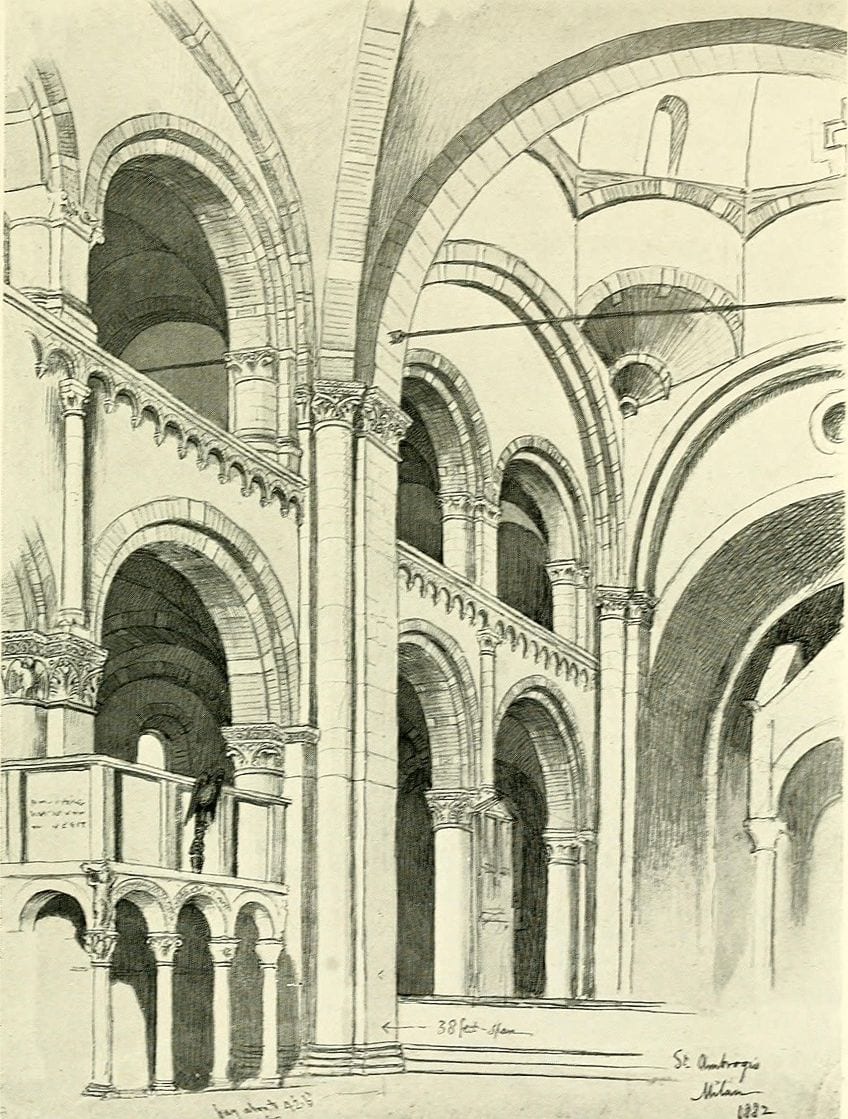 An example of Romanesque architecture; Net Archive Book Images, No restrictions, via Wikimedia Commons
An example of Romanesque architecture; Net Archive Book Images, No restrictions, via Wikimedia Commons
De Gerville'southward colleague, Arcisse de Caumont, described the architecture he saw as "debased Roman architecture". He likened it to the Romance languages that were not Latin, describing them equally the "degenerated Latin language".
The Romanesque definition was too expanded on past the English writer, William Gunn. He utilized this term in an official publication to draw the architectural mode from the Medieval catamenia before the Gothic period. This was published in An Inquiry into the Origin and Influence of Gothic Compages (1819).
The term's usage evolved over time to designate the architectural style during the 900s until 1100s CE.
Out of the Dark Ages: A Brief Historical Overview
Before we wait at the Romanesque art period, it will help us to understand how this period evolved. The Romanesque menstruation took place during a time in Europe's history called the Medieval period, or Middle Ages. The Medieval menses started with the fall of the Roman Empire effectually 476 CE and lasted to around the tardily 1400s, which was when the Renaissance period brought new light to a darkened Western earth.
The Roman Empire fell because of the widespread disintegration of the political system, invasions from Germanic and other tribes, as well every bit many other debated factors related to its decline. The Roman Empire was besides divide into dissimilar parts, which weakened its ability to fight dorsum against the invading tribes.
The Medieval period (which developed afterwards the Roman Empire's destruction) has been divided into three periods: Early on, Loftier, and Tardily. During the Medieval menses, there was new growth in the Western earth's economic system, club, organized religion, and cultures.
New kingdoms were being shaped and with the influx of dissimilar cultures, languages evolved beyond just Latin and Greek.
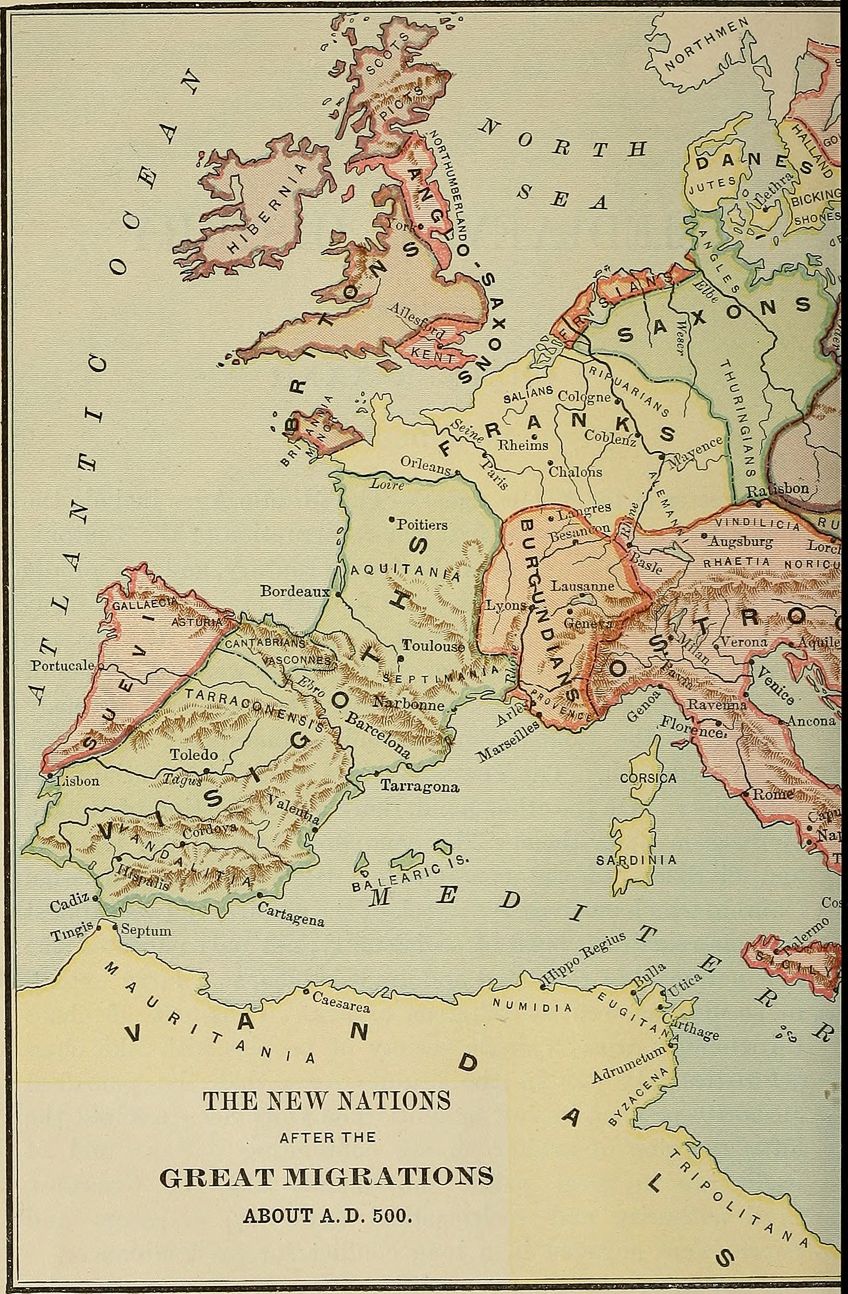 The new nations after the great migrations during A.D. 500; Internet Archive Book Images, No restrictions, via Wikimedia Commons
The new nations after the great migrations during A.D. 500; Internet Archive Book Images, No restrictions, via Wikimedia Commons
The Migration Catamenia was as well some other part of the Medieval period because, not only did various tribes invade the Roman Empire, but there was also a mass migration of these tribes into the Roman Empire. Some of the tribes were Germanic, similar the Anglo-Saxons, the Goths, the Lombards, the Vandals, and some were Eurasian like the Slavs.
During this period, at that place was also religious discord between the Eastern and Western European countries. This was marked past what was known equally the East-West schism in 1054 CE, where the Roman Catholic Church (which was run by the Pope in the West) was separated from the Eastern Orthodox Church in the East (run by the Ecumenical Patriarch of Constantinople).
There were thousands of changes and developments during the Medieval period – developments in politics, religion, and the arts throughout many countries. What is of import to sympathize virtually this vast and complex fourth dimension is that religion played an of import role in society. The Early Middle Ages also saw the rise of monasticism.
The "Father of Europe"
Charlemagne, otherwise known as Charles the Great, was a pregnant effigy during the Medieval period considering he was responsible for the reunification of the Western and Central European countries. His coronation every bit Emperor of Rome was held in 800 CE, and prior to this he was the King of the Franks in 768 and King of the Lombards in 774.
He was also the first emperor since the Roman Empire fell (estimated effectually iii centuries prior), and with this, he reunited regions in Western Europe that had not been united since. He came to be considered as the "Begetter of Europe" because of his unifying force.
The Carolingian Empire gave rise to the Carolingian Renaissance, which was an important office of Medieval history because it was a period of cultural development in various disciplines like the arts, architecture, literature, music, and liturgical religious practices.
Charlemagne himself was a patron of the arts and he sought to emulate the ideals from the Classical Roman Empire by constructing various religious buildings; architecture was an important part of the Carolingian Empire.
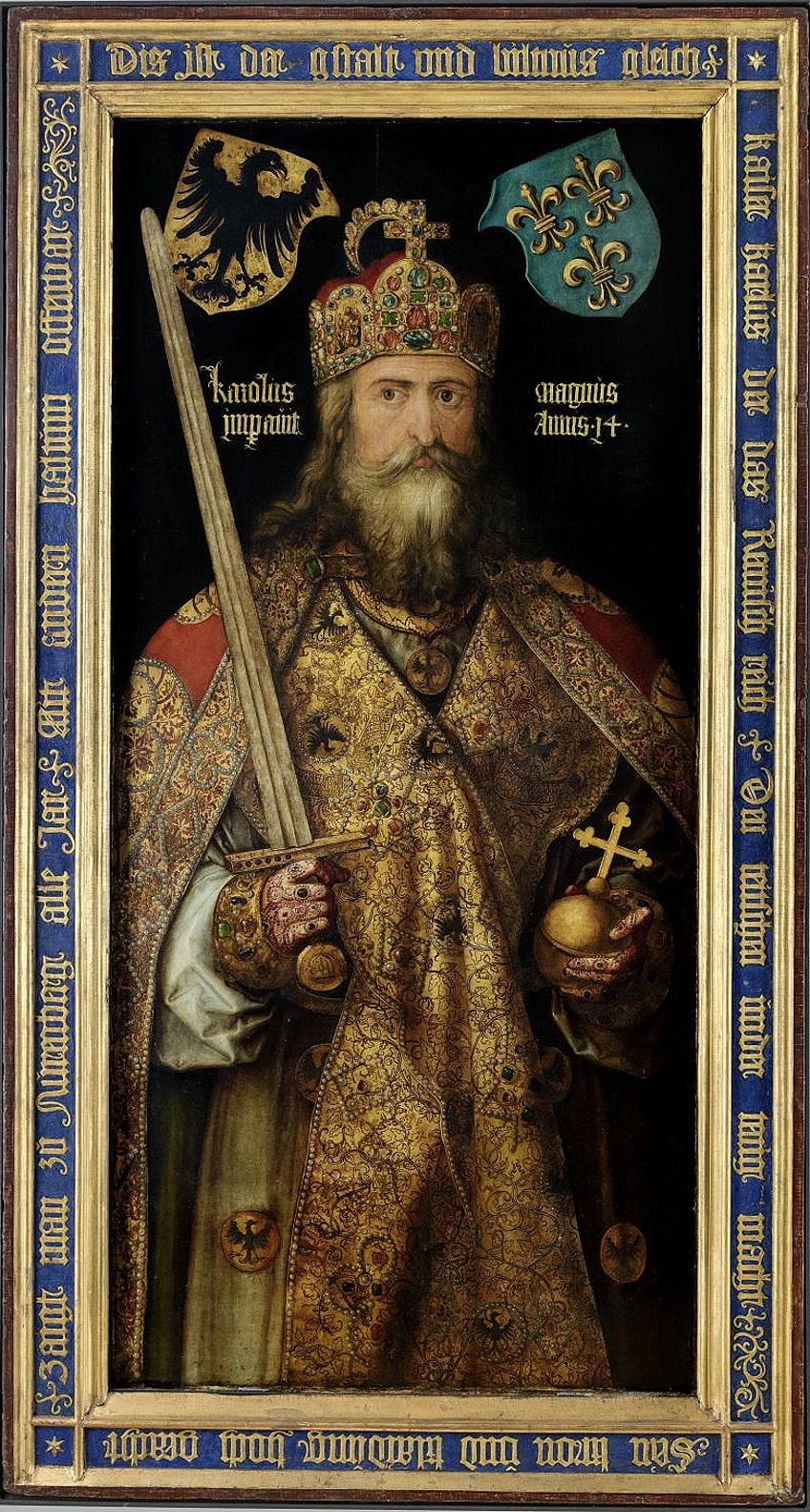 Emperor Charlemagne, painted past German language artist Albrecht Dürer in 1511-1513;Albrecht Dürer, Public domain, via Wikimedia Commons
Emperor Charlemagne, painted past German language artist Albrecht Dürer in 1511-1513;Albrecht Dürer, Public domain, via Wikimedia Commons
Professor of History, John Contreni, is often quoted providing estimates of just how many buildings Charlemagne fix out to build during his reign. Contreni stated that "the little more than eight decades between 768 to 855 alone saw the construction of 27 new cathedrals, 417 monasteries, and 100 royal residences".
There were influences from Roman and Byzantine styles in Carolingian compages, especially when we look at churches.
Churches were more often than not congenital following the layouts of basilicas, which were public buildings during ancient Roman times. The structure of the churches was also changed to accommodate various religious ceremonies. Some of the changes consisted of the entrances condign due west-facing, otherwise known equally westworks, and the eastern ends of the church housing the altars. The western fronts were commonly done at monumental scales.
These Carolingian architectural structures laid the foundation for the Romanesque periods to come, and are usually described as the Pre-Romanesque period in Northern Europe. An example of this is the Palatine Chapel in Aachen (792 to 805), which has the characteristic western front.
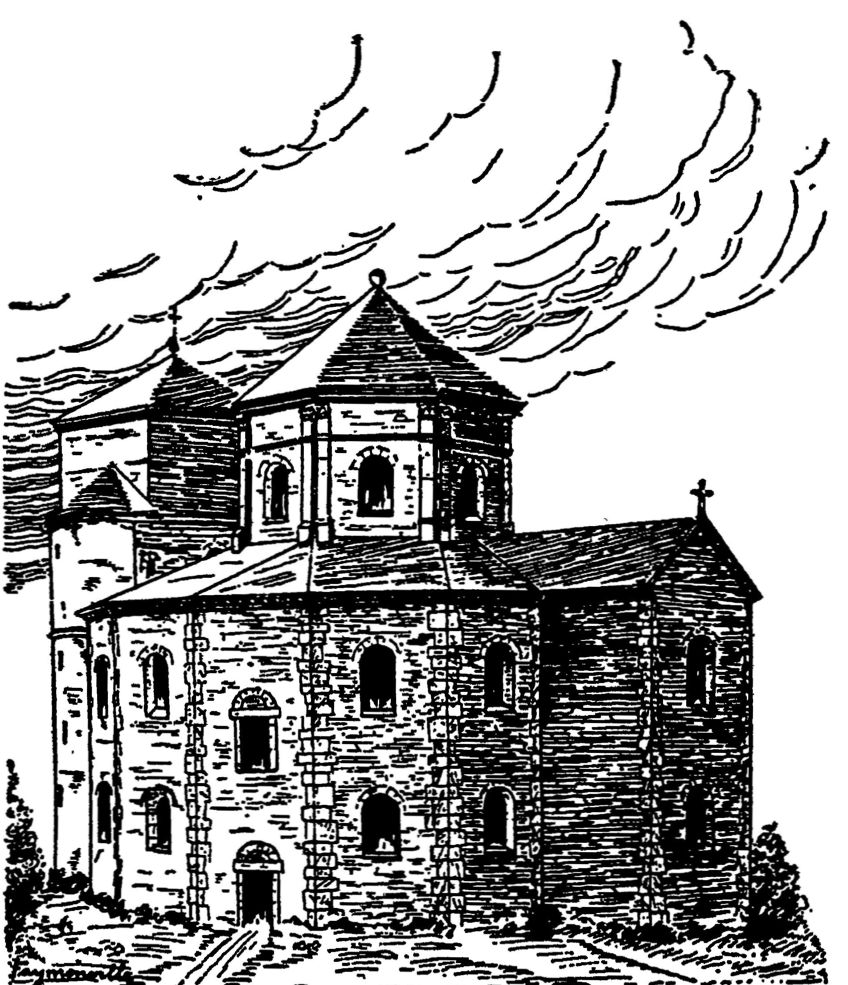 Charlemagne'due south church in Aachen;Unknown author Unknown author, CC0, via Wikimedia Commons
Charlemagne'due south church in Aachen;Unknown author Unknown author, CC0, via Wikimedia Commons
The artwork produced during the Carolingian Renaissance was curt-lived, notwithstanding, only lasting between 800 to 900 CE. In that location was a resurgence of Roman influence, such every bit murals like frescoes, mosaics, illuminated manuscripts, metalwork, and sculptures. Figures were also depicted with more naturalism, as we see from the Classical Roman murals.
Later the Carolingian Empire
The Carolingian Empire came to an end during the 900s CE, and the period of what seemed to be growth declined. There were various reasons for this – some of them included Viking invasions, which likewise saw the destruction and pillaging of many sacred churches.
The Ottonian Renaissance occurred during the reign of Otto I, or Otto the Great. His coronation equally Holy Roman Emperor was in 962 CE. As another patron of the arts, art and architecture during this menses were primarily for the royal courts and monasteries.
This was not a widespread artistic or cultural motility; nonetheless, it is of import to place it contextually equally information technology was a forerunner to the Romanesque period.
Another important marker in Romanesque history was in 1066 when William, the Duke of Normandy, invaded England. At that place was an increase in buildings that acted every bit fortifications, like castles and strongholds, which also showed that it was Norman territory.
The Crusades during 1095 to 1270 CE also increased the spread of cultural ideas and various skills in crafts like masonry and metalworking. There was besides an influence from the Eastern European fashion of compages, namely architectural domes from Constantinople.
Romanesque Art and Architecture
Romanesque art certainly evolved over many dissimilar periods in Western European history, with many figures in power rising and falling. The Romanesque fashion can be characterized past several features, however, what is important to annotation is that despite there existence many overall similarities, there were differences in the Romanesque compages of different regions like Italy, the British Isles, French republic, and Normandy.
There were important historical factors that signified the Romanesque period also, for example, Monasticism. This became a widespread religious endeavor across Europe, and monasteries became centers where people could stay during pilgrimages. Additionally, these were sites that housed religious relics.
Below, we discuss various Romanesque fine art characteristics as well every bit some of the prominent artworks like paintings, ornaments, and tapestries from the principal regional styles throughout Europe.
Romanesque Art Characteristics and Types
Romanesque architecture shares some common features regardless of the regional differences. It is often described every bit "sturdy" and "solid" in structure. Notable similarities across regions would be thick walls, smaller windows, and columns, which would usually alternate with piers. Columns were made in the form of stone drums, which were thick and large to provide enough stability and support for the walls, roof, and vaulting above.
Other common features included arches between the columns and piers, equally well equally decorative arcades – either inside or outside – in the course of "bullheaded" arcades. These were a series of archways with no openings, and typically with a wall behind it.
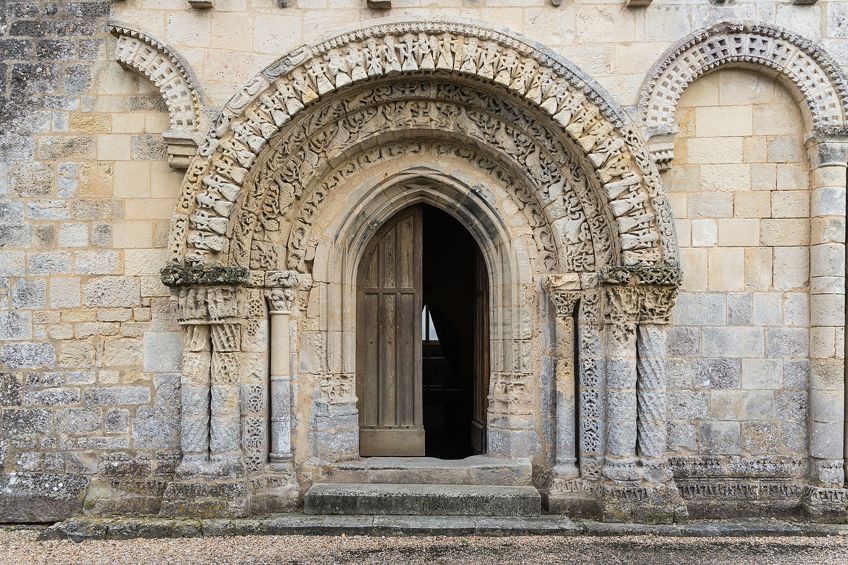 The Romanesque portal of the church of Our Lady in Avy, Charente-Maritime, France;Jebulon, CC0, via Wikimedia Commons
The Romanesque portal of the church of Our Lady in Avy, Charente-Maritime, France;Jebulon, CC0, via Wikimedia Commons
There were different types of vaulting, for example, the Barrel Vault, the Groin Vault, Ribbed Vault, and Pointed Arch Vault. Domes were also characteristic features in churches, and it is hither that we often see Romanesque paintings depicted as murals or mosaics, especially in the apse surface area.
When information technology comes to Romanesque paintings, not many take survived, although typical themes include that of the Last Judgment, Christ in Majesty, and diverse other scenes from the Onetime Testament. These were likewise painted on the arches, called the tympanum, above church entrances (these as well included Romanesque sculptures).
Romanesque paintings were painted for didactic (educational) purposes due to many people beingness illiterate during the Medieval ages. Murals also depicted the figure of Christ within an oval frame called a mandorla, where he would be surrounded by various figures or animals from the Bible. The iconographic style from the Byzantine menstruation also stylized the various depictions of Christ.
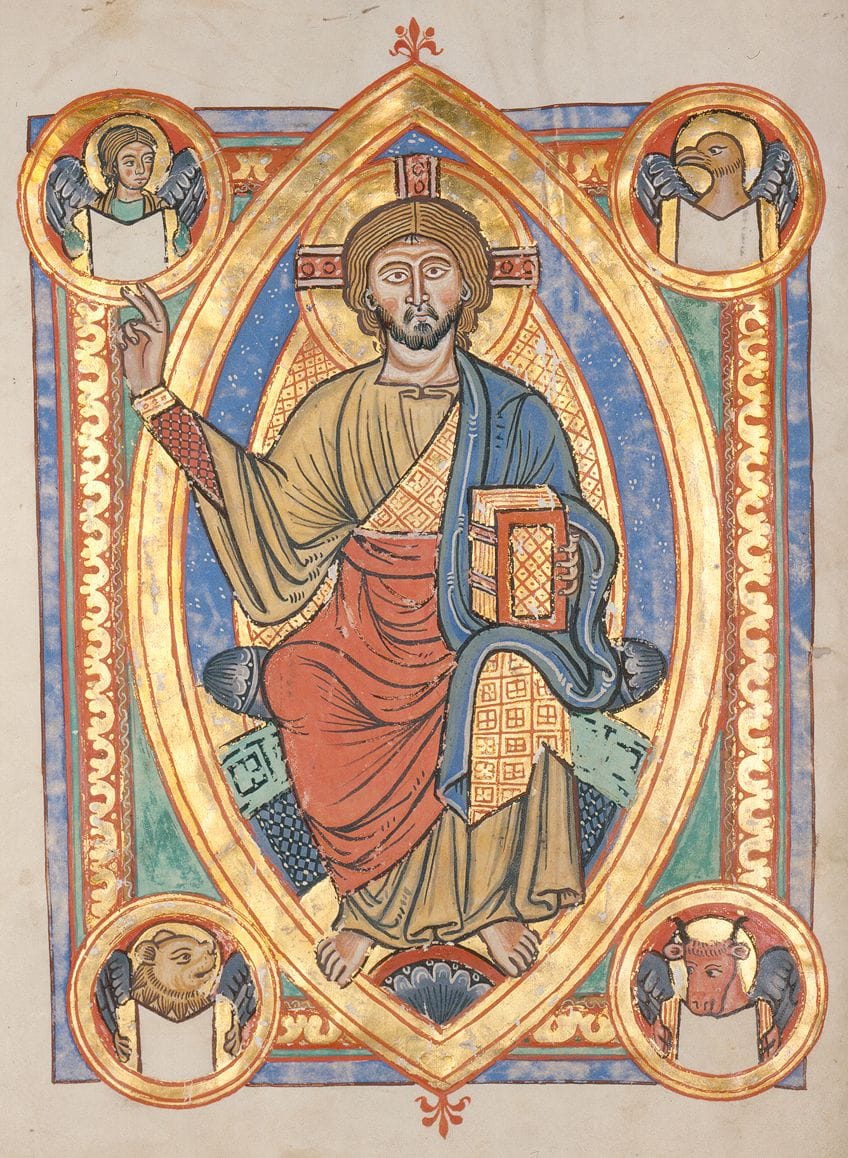 Christ mandorla in an illuminated manuscript, c. 1220;medieval, Public domain, via Wikimedia Commons
Christ mandorla in an illuminated manuscript, c. 1220;medieval, Public domain, via Wikimedia Commons
When we look at Romanesque sculpture, nosotros see it in the capitals on columns, often in Corinthian Order, as well as on the tympanums above church entrances, which were washed in relief carvings. Although sculpture subject affair was ofttimes of biblical stories, in that location were other decorative motifs unremarkably used, such as spirals.
We see these types of decorative motifs in Roman architecture too, referred to by sources equally "scrolling vines".
These were besides used to decorate manuscripts. An example of the elaborate sculpture and decorative motifs is on the tympanum of Vézelay Abbey (c. 1120 t0 1150), which depicts images from the First Crusade and the Apostles' purpose to pb people towards God.
Other types of fine art were done with metalwork, ivory, and enamel. These would frequently be used to brand sacred objects. For example, the famous Stavelot Triptych (c. 1156 to 1158), which is made from golden and enamel, is a mobile altar made by Mosan artists from the Meuse Valley located in Belgium. Mosan artists created varieties of metalwork, stonework, enamel piece of work, also equally illuminated manuscripts.
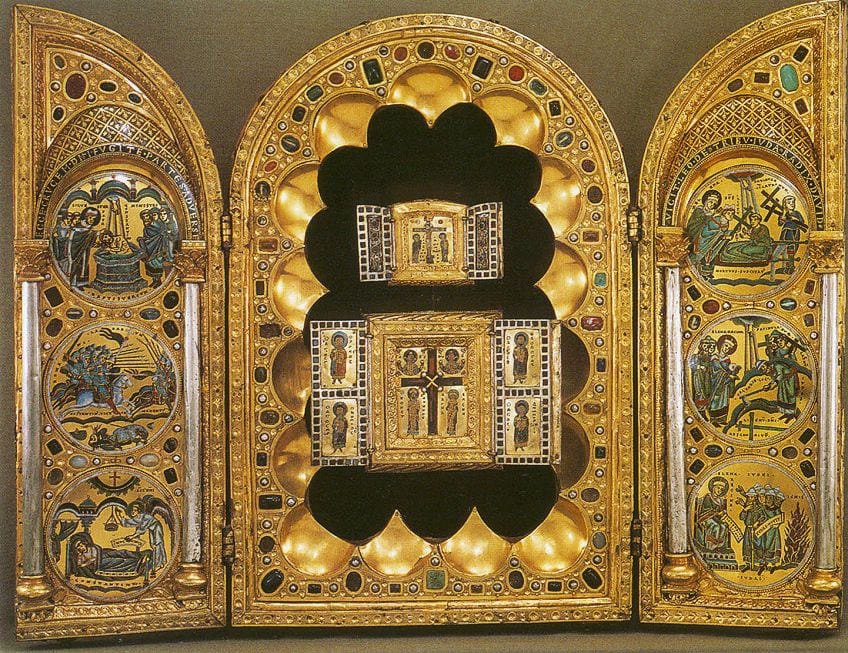 Stavelot Triptych (c. 1156 to 1158);Original File Uploaded by en:User:Stbalbach, Public domain, via Wikimedia Commons
Stavelot Triptych (c. 1156 to 1158);Original File Uploaded by en:User:Stbalbach, Public domain, via Wikimedia Commons
Embroidery and stained-drinking glass windows were also dissimilar types of artworks that were often utilized every bit decorations inside the churches. We see stained drinking glass windows more than prominently during the Gothic period, although sources propose that remnants of the Romanesque menstruum were used for rebuilding during the Gothic period. Stained glass also replaced the employ of tapestries.
The Cluny Abbey
The Cluny Abbey was a significant religious building during the 900s CE. Information technology began equally a donation of land to class the hunting lodge of Duke William I of Aquitaine. The abbey was started as a reform of the Dominion of St. Benedict. The abbey was also independently run – the Pope was the simply authority over information technology. This enabled the abbey to build more monasteries in France, as well as to fortify the Rule of St. Benedict.
Cluny's liturgy became well developed and because of this, it grew into an important artistic hub.
Three successive churches were built at Cluny, which as well highlights the feature Romanesque architectural way. There was Cluny I, Cluny Two, and Cluny Iii. Cluny I was a simple structure in pattern, but it was Cluny Two that emulated the Romanesque designs.
 Footplan and hemi-perspective elevation of Cluny Abbey church building in late 17th / early on 18th century;Pierre Giffart, Public domain, via Wikimedia Commons
Footplan and hemi-perspective elevation of Cluny Abbey church building in late 17th / early on 18th century;Pierre Giffart, Public domain, via Wikimedia Commons
Cluny Two had the typical westworks, being the west-facing front with the 2 accompanying towers. Between the entrance and the residue of church inside was a narthex, which had a choir with 2 chapels on either side on the east-facing side of the church (we run into this style in time to come church building designs).
The transept was situated just before the choir, horizontally crossing with the vertical nave, which gave the church the cruciform plan. The layout of the church was of a rectangular basilica, which consisted of a nave (the central floor space) surrounded past aisles on both sides.
Other characteristics of Cluny Abbey were the barrel vaults and round arches, a typical characteristic of Roman architecture. Cluny III was rebuilt and finished ruing the year 1130 and was considered the largest structure in Europe.
With boosted embellishments to the already existing structures, it was a monumental sight to see.
The Cistercians and Fontenay Abbey
The Cluny abbey became a circuitous structure and a powerful system inside the reform movement – the Cluniacs were seen as besides "worldly", having become too engrossed in earthly endeavors. This period of reform is referred to as the Cluniac movement. It was succeeded past the Cistercian movement. The Cistercians were monks that split from the Benedictine orders of Cluny to continue what they believed was in accordance with St. Benedict of Nursia'southward style.
Fontenay Abbey is some other example of Romanesque architecture, founded by Saint Bernard of Clairvaux in 1118 CE.
In the program of a Latin cross, this church building was simpler in its design and construction, made from ashlar rock. There was a focus on reducing the number of decorative elements like towers and ornaments so that the monks were non distracted.
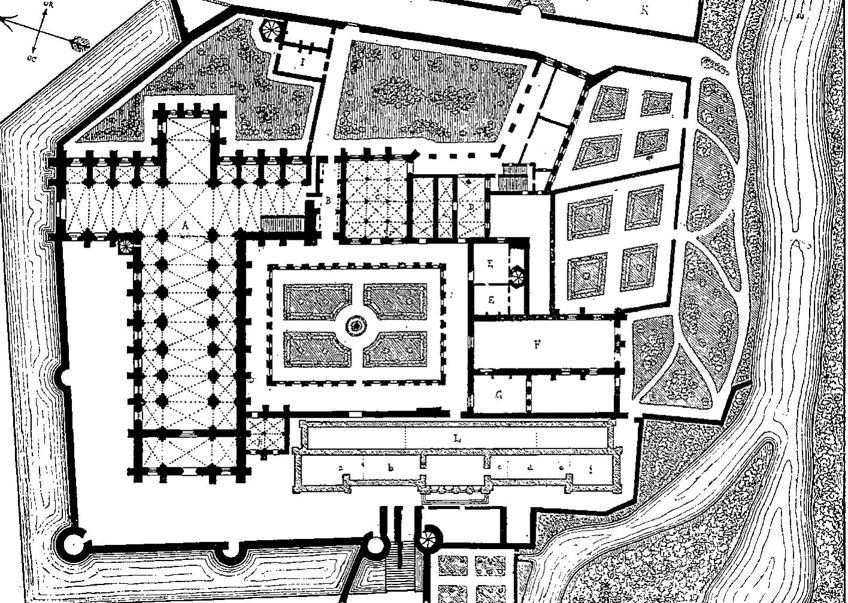 Fontenay Abbey and Cistercian compages;Lucien Bégule (1912), Public domain, via Wikimedia Eatables
Fontenay Abbey and Cistercian compages;Lucien Bégule (1912), Public domain, via Wikimedia Eatables
Forth the east side, the apse is flat, which is in contrast to the curved apses seen in other churches. In that location are also two chapels on either side, both square-shaped. We still run into the classical Romanesque style, nonetheless; in fact, the church has been described as a shut correlation to that of Greek temple.
There is a nave with the accompanying side aisles. Along the nave and near the stop of information technology are barrel vaults, which have slight points (indicative of the Gothic way of architecture). We besides notice columns embedded in the nave columns, which extend into the above transverse arches.
The First Romanesque Style
The Romanesque architectural styles took place regionally, which ways buildings had slight variations of mode and edifice materials. When we wait at the Romanesque period in fine art it is subdivided, beginning with the Start (or Lombard manner) and and so the Romanesque style. The First style was coined equally a term by Josep Puig i Cadafalch, who was a Spanish architect. He thought the Catalonian style had similarities to the Romanesque period, although it took place during the later stages of the Pre-Romanesque period.
The First style started in Lombardy in Italy during the 1000s CE, but besides occurred in Catalonia in Kingdom of spain, as well as southern France. The Comacine Guild was started by stonemasons in Lombardi, also called the Magistri Comacini or Comacine masters, who pioneered this architectural style. Diverse sources bespeak their start mention was by Male monarch Rothari of Lombard in his edict in the year 643 CE.
There are several distinguishing features of this mode, namely that information technology was not elaborate in design or details and that there were no sculptures.
It had thick walls, oft also described as "solid" in construction. The Lombard bands, as well called "blind arches", are horizontal strips of arches without any opening placed across areas on the exterior of buildings. These were common features during this period.
 Sant Climent de Taüll in the Vall de Boí;Nur.ra, CC BY-SA 3.0, via Wikimedia Commons
Sant Climent de Taüll in the Vall de Boí;Nur.ra, CC BY-SA 3.0, via Wikimedia Commons
There was also the use of open arches, which would be vertically placed to adorn the exterior of the buildings. An instance of this is the reconstruction of the front end side of the Santa Maria de Ripoll Monastery (1032). Some other example includes the at present UNESCO Earth Heritage Site, Vall de Boí, which has nine church building buildings located in the villages in the valley of the Pyrenees.
The churches in the valley take been noted for their architectural placement inside the rural areas of the Pyrenees. The churches were all built between the 1000s and 1100s CE. An example of one of these churches is the Sant Climent de Taüll, which was constructed in 1123. This church is as well ane of the best-preserved churches in the valley.
The floorplan is in the basilica design with three naves. We will find the decorative arches, otherwise also known as "arcading" on the bell tower, or tower, which consists of seven stories (although some sources say half dozen stories).
There are no sculptural decorations on the outside of the church building, and it appears "solid" in its simplicity, which is characteristic of the Romanesque manner.
The interior of the church has various mural paintings, which include the more than famous fresco titled, Christ Pantocrator (c. 1123), by an artist referred to every bit the Master of Taüll. It depicts the primal figure of Jesus Christ in a mandorla shape painted on the semi-circular dome of the church (a common feature for paintings in churches).
 Christ Pantocrator (c. 1123) fresco in the alcove of Sant Climent de Taül;David Monniaux, Public domain, via Wikimedia Eatables
Christ Pantocrator (c. 1123) fresco in the alcove of Sant Climent de Taül;David Monniaux, Public domain, via Wikimedia Eatables
He sits with a small depiction of the earth below his feet. He holds upwards his right mitt in the gesture of approving and he holds a book in his left mitt. At that place are various other biblical figures and animals surrounding the figure of Christ. The colors used are a variety of blues, reds, and yellow. This painting has become well-known throughout history, with mod artists like Picasso cartoon inspiration from information technology.
Norman Romanesque Fashion
The Norman Romanesque manner was an English style, primarily started by the Normans who were descendants of the Vikings – Normandy was also subsequently named after these groups. The Norman style developed from the resulting invasions around the year 1066, which was when the Normans took over England.
The English builder, Thomas Rickman, coined the term "Norman Romanesque" in his publication, An Attempt to Discriminate the Styles of English Architecture from the Conquest to the Reformation (1817). This was the first usage of the term to depict the regional style among other sequential Romanesque styles.
The Norman style can exist seen in churches and cathedrals, although in that location were also many castles and fortifications.
The way has rounded arches and is known to have big walls and proportions. The Norman arch was a common characteristic of this fashion, which was usually semi-round in shape and built as large archway entrances that created a sense of grandiosity.
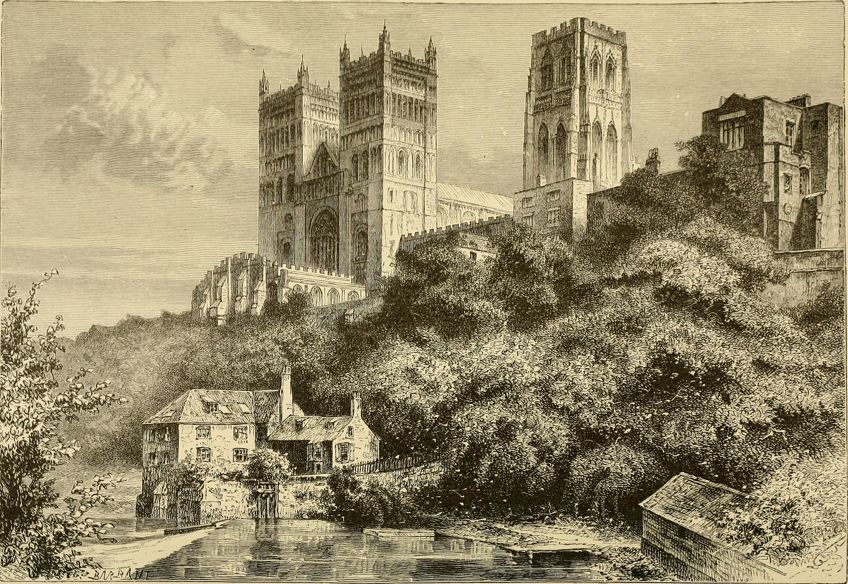 An 1881 drawing of Durham Cathedral; Reclus, Elisée, 1830-1905;Ravenstein, Ernest George, 1834-1913;Keane, A. H. (Augustus Henry), 1833-1912, No restrictions, via Wikimedia Eatables
An 1881 drawing of Durham Cathedral; Reclus, Elisée, 1830-1905;Ravenstein, Ernest George, 1834-1913;Keane, A. H. (Augustus Henry), 1833-1912, No restrictions, via Wikimedia Eatables
The Durham Cathedral (1093 to 1140) is an example of the Norman style. Information technology is one of the largest and most monumental structures ever built and is renowned for its scale. Various structural elements include ornamental decorations. In fact, the building is copiously decorated in what is referred to as overlapping decorative arcading as well as a feature band of chevron-similar zigzags, spirals, flutes, and lozenges along with the thick columns and semi-circular arches.
The interior of the church has tall columns and piers every bit well as barrel vaulting above. The whole interior appears monumental in calibration. The pregnant and motivation behind the large scale of the church take been a common question amidst many scholars.
Another famous artwork from the Norman style is the Bayeux Tapestry (c. 1070), which depicts the historical events prior to and of the conquest of England between William, Duke of Normandy, and Harold Godwinson (Harold II), Earl of Wessex. The tapestry's length is 230 feet with over 70 scenes. In that location are Latin inscriptions, otherwise known equally tituli, to describe the events, which are embroidered with woolen yarn into the cloth (as opposed to being weaved on tapestries, which was the norm).
 A scene of the Bayeux Tapestry depicting horses being shipped to England by Normans prior to their invasion, 11th century;Bearding Unknown author, Public domain, via Wikimedia Commons
A scene of the Bayeux Tapestry depicting horses being shipped to England by Normans prior to their invasion, 11th century;Bearding Unknown author, Public domain, via Wikimedia Commons
The commissioner or patron of the tapestry is reported by many scholars to have been the Bayeux Bishop named Odo (he was also the one-half-brother to the Duke of Normandy), who is also depicted in the tapestry. The tapestry is believed to take been created in Canterbury, England, and depicts a more than biased Norman perspective of the conquering of England and the Boxing of Hastings in 1066.
The "Bayeux Tapestry" is 1 of the more famous embroidered art pieces from the Norman art style.
On the larger macrocosm of the Romanesque fine art menstruation, this tapestry goes beyond the part every bit just art because information technology is a rich and detailed delineation of war, politics, and a record of how the Normans prepared for battle, dined, and engaged with one some other.
Italian Romanesque Style
The Italian Romanesque way, especially the Pisan Romanesque style (as well called the Tuscan manner), occurred during the 1000s CE to 1200s CE. It was characterized past more elaborate sculptural decorations, inside and outside the church building. We volition also notice numerous decorative arcades.
A famous instance is the Piazza dei Miracoli or Piazza del Duomo ("Cathedral Square"), the architectural complex housing the Pisa Cathedral (1063 to 1092), the Pisa Baptistry (1153), and the famous Leaning Tower of Pisa, also called the Campanile (1173 to 1372).
 The Duomo and Tower of Pisa at sunrise; MHoser, CC BY-SA 4.0, via Wikimedia Commons
The Duomo and Tower of Pisa at sunrise; MHoser, CC BY-SA 4.0, via Wikimedia Commons
The Duomo di Pisa, which is the front entrance of the Pisa Cathedral, is a lavishly decorated façade. There are 3 doorways, with "blind" arcades next to each one (totaling 4 blind arcades interspersed betwixt the existent doors). Some of the influences on this building come from the Lombard Romanesque style, also as Islamic and Byzantine styles. Nosotros see the characteristic Lombard bands on the arches and columns. In that location are crescent-shaped Romanesque paintings in a higher place each doorway with Islamic-styled shapes described every bit diamonds and circles.
The levels above have arcades and columns that appear elaborately decorative when the building is viewed from afar. Nevertheless, when viewed shut-upwards, we also come across the level of detail in each part of the building.
The Romanesque Style Continues to Influence
The Gothic style developed in Paris effectually the year 1120 CE, which then started to stage out the Romanesque period. However, the advent of the Gothic style still utilized Romanesque influences. For instance, churches continued to utilise the cruciform pattern plans, including the western-facing façade with the characteristic 2 towers.
In the 1800s, there was a Romanesque revival in various buildings and churches. Some mutual examples include the Natural History Museum (1879) located in London. Other buildings in America include the Maaronite Cathedral of Our Lady of Lebanon (1844 to 1846) by Richard Upjohn.
The manner has also been adapted past the American architect Henry Hobson Richardson, who designed buildings like the Marshall Field Wholesale Store (1885 to 1887) located in Chicago. This was later known equally the Richardsonian Romanesque style with various other architects working aslope Richardson and his style.
The Romanesque style became a foundational precursor to other architectural styles. Not only did it borrow from Classical compages, simply it also crossed paths with Byzantine styles. It was non only relegated to architecture merely spanned beyond various creative modalities similar illuminated manuscripts and mosaics. From Classical to Modern, the Romanesque manner has been adjusted and molded to accommodate churches, cathedrals, department stores, and warehouses.
Take a await at our Romanesque fine art menstruum webstory hither!
Often Asked Questions
What Is Romanesque Fine art?
Romanesque art was primarily an architectural mode that drew from the Classical Greek and Roman architectural styles. It also drew inspiration from Byzantine and Islamic styles. This art period did not only include architecture, however – at that place were other art forms similar metalwork, sculpture, painting like murals and mosaics, embroidery, and stained drinking glass.
When Did the Romanesque Catamenia Start?
The Romanesque period occurred during the Medieval, or Heart Ages. It started around the mid-10th century CE until the 12thursday Century CE. Information technology originated in different parts of Europe, predominantly France, Italia, England, and Northern parts of Europe like Germany.
What Are the Characteristics of Romanesque Architecture?
The common characteristics of Romanesque compages are solidity, strength, thick and large-scaled walls, piers, and columns (either pocket-size or large, depending on the placement within or outside the church). Other features include arches, usually called "blind" arches and decorative arcades. Buildings unremarkably had wooden roofs and vaulting in the forms of Barrel, Ribbed, Groin, and Pointed Curvation. Entrances were west-facing with characteristic towers, sometimes one tower on smaller churches and two towers on larger cathedrals.
rotherbehienceeten51.blogspot.com
Source: https://artincontext.org/romanesque-art/
0 Response to "Did Romanesque Art Leave Any Room for Individual Expression and Innovation"
Post a Comment